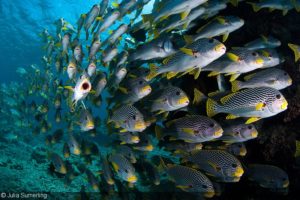
Sweetlips schooling on the Ribbon Reefs
Stretching 1,400 miles (2,300 kilometers) along Australia’s northeast coastline—the same distance from New York City to Miami—the Great Barrier Reef (GBR) is the planet’s largest living structure and the only one of its kind on Earth visible from space. This World Heritage Site is a system of some 3,000 individual reefs and around 900 coral islands, home to a highly biodiverse collection of marine animals, including over 1,500 different species of tropical fish. Immediately to the east of the GBR is the Coral Sea Marine Park, which is approximately the same length but covers around four times the area.
In the remotest parts of the region, underwater photographers can expect to see pristine hard corals with a biodiversity unequaled anywhere else. You can spot seven species of shark on a single dive and drop-offs where sharks number in the hundreds. The visibility can be breathtaking, reaching almost 250 feet in the Coral Sea. But most of all, the GBR and its surrounding sea are all about expecting the unexpected—there is so much still to learn about this vast region of the planet.
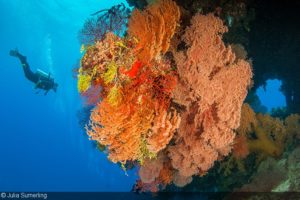
Incredible colour at the Holmes Reef
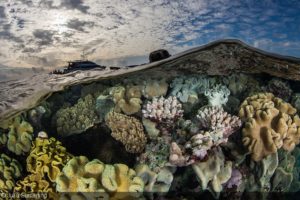
Stunning shallow corals on the Ribbon Reefs
Top Six Places to Dive in the GBR and the Coral Sea
1. SS Yongala
A 350-foot shipwreck located 11 nautical miles from the shore, the SS Yongala is easily accessible from Alva Beach, just south of Townsville, or via liveaboard. The vessel sank in a very exposed area that gets no protection from the reef, and it lies on its side on the sandy bottom at a depth of 90 feet. The Yongala has become an oasis to marine life. At times, it is so densely populated with life that one can hardly make out the wreck due to the sheer number of fish.
The constant presence of apex predators makes this a wild and exciting dive. The wreck is also a huge cleaning station for the megafauna in the area, and is regularly visited by Queensland groupers, marble rays, eagle rays, guitar sharks, manta rays, bull sharks, maori wrasse, sea snakes, turtles, and occasionally even whale sharks and humpbacks. On a single dive, schools of barracuda, sweetlips, batfish, trevally, queenfish, cobia, cardinalfish and snappers can be seen. The hardest thing for the photographer is choosing where to point the camera. It’s very easy to forget that this shipwreck is the site of one of Australia’s worst maritime disasters, where all 121 lives on board were lost in March 1911.
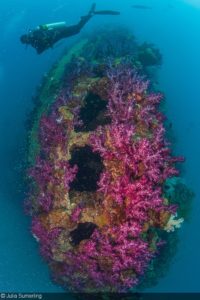
The coral-encrusted SS Yongala
2. Far Northern Great Barrier Reef
The region encompassing the Great Detached Reef to the North Broken Passage is home to some of the remotest reefs in the GBR. Its an overnight steam north of Lizard Island by liveaboard from Cairns, but those who make the trek will not be disappointed. Over 150 different species of coral can be found here—some of the most stunning coral structures anywhere in the GBR region.
On one dive, seven species of shark are regularly photographed: whitetip reef sharks, gray reef sharks, great hammerheads, tawny nurse sharks, leopard sharks, epaulette sharks, and blacktip reef sharks, but lucky divers will also be treated to whale sharks and oceanic whitetips. Manta rays, eagle rays and mobula rays are also common photo subjects, as is the macro life, including Rhinopias, harlequin ghost pipefish, scorpionfish, and nudibranchs of all colours, shapes and sizes.
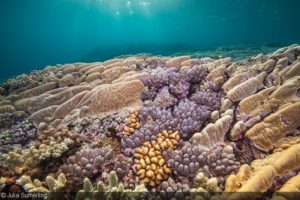
Great Detached Reef in the far northern GBR
3. North Horn, Osprey Reef
The Coral Sea’s Osprey Reef is a big coral atoll, the shape of a teardrop, and North Horn is its very northernmost point. The currents here can get very strong, but this is what brings in the big animals, including a large school of gray reef sharks that ride the current and use it to assist them in cleaning. Certain times of the year will bring whale sharks, schools of scalloped hammerheads, dogtooth tuna, potato cods, and manta rays, as well as occasional sightings of thresher sharks, tiger sharks and great hammerheads.
The western facing wall has spectacular soft corals of bright reds, yellows and oranges that cascade from 30 to 250 feet. Visibility is often 200 to 250 feet and the wall plummets straight down into the depths at 6,500 feet. On night dives, you’ll see flashlight fish and countless different crustaceans. Photographers can literally spend the whole day here for four or five dives and they still can’t get enough.
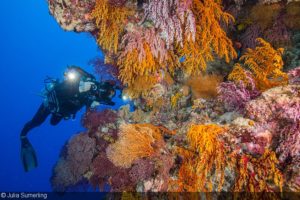
The Western Wall at the Osprey Reef’s North Horn
4. The Ribbon Reefs
The Ribbon Reefs are the long, skinny reefs that lie between Lizard Island and Cooktown on the edge of the continental shelf of the northern GBR. This is a great place to get those classic GBR images of turtles, sea snakes, cuttlefish, scorpionfish, and many species of anemonefish in bright, colourful anemones. The dives are relatively easy and the area can be visited all year around in most weather conditions as the outer reef acts as a barrier to big ocean swells, making it comfortable for vessels.
Many of the dive sites are narrow pinnacles that rise from around 100 feet to just a few feet at the surface. Pinnacles such as Steve’s Bommie, Lighthouse Bommie and Pixie Pinnacle are favourites of macro shooters. Peacock mantis shrimp, leafy scorpionfish, Rhinopias, anemonefish, pipefish, nudibranchs, stonefish, and longnose hawkfish are all easy to find and photograph.
On Ribbon Reef #10, you’ll find one of the world’s best-known dive sites—Cod Hole. As the name suggests, this is the hangout of Australia’s famed potato cod, or giant Queensland grouper, and after years of being fed by divemasters, these heavyweight fish are very willing photo subjects.
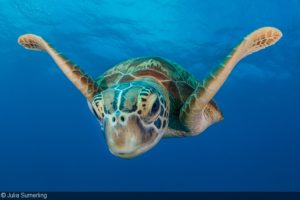
A green turtle cruises the Ribbon Reefs
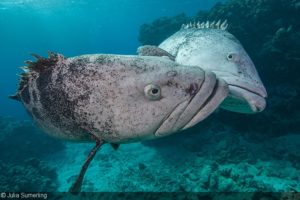
A pair of potato cod at the famed Cod Hole
5. Minke Whale Season on the Ribbon Reefs
In the winter—June and July—the Ribbon Reefs play host to migrating dwarf minke whales. These small rorqual whales, which average between 20 and 25 feet, frequent the waters where the dive sites are and will actively engage with snorkelers at the rear of the vessel. If you hold onto a line and move as little as possible, the whales get particularly inquisitive and will swim as close as 10 feet from you.
Encounters typically last 90 minutes, with as many as 20 individual animals during an encounter. Some encounters have lasted up to 14 hours—with divers losing interest before the minkes! Whales have also been known to follow boats and continue to engage with divers when they re-enter the water.
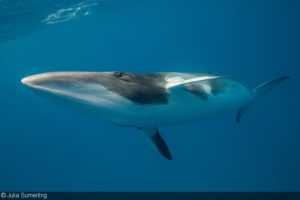
A graceful dwarf minke whale
6. Osprey, Bougainville and Holmes Reefs
This collection of small coral atolls in the Coral Sea is approximately 100 nautical miles east of the GBR and between 60 and 100 nautical miles from one another. Each atoll is well worth spending a full day at, and when the weather allows, all three can be visited in three days on a Coral Sea expedition.
Far from land and unaffected by land runoff, the waters here commonly boast visibility of 130 to 230 feet. Large caverns and swim-throughs have been formed from many years of big ocean swells and water rushing in and out of the lagoons. Big schools of barracuda, trevally and sharks patrol the area. And the soft corals have the rich reds and yellows that every underwater photographer craves.
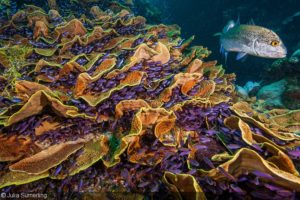
Anthias hiding from hunting trevally at the Bougainville Reef
Underwater Photo Equipment for the GBR and the Coral Sea
Choosing the right equipment for diving the GBR and the Coral Sea is always a tough decision, as many of the sites have both excellent macro and wide-angle subject matter. It’s all too easy to have a macro lens mounted when a manta ray shows up. As such, shooters that have a flexible rig with macro and wide-angle wet lenses (preferably on flip mounts) will be at a natural advantage. High-quality wet lenses not only make it easy to get great wide and close-up shots on the same dive, but they are also ideal for shooting video and telling stories in varied and interesting ways by using different focal lengths and camera angles.
If you aren’t using wet optics, be sure to check with your dive guide before getting in the water and finding out what they are expecting to see—this will help you to make the right choice of lenses to use for which dives. However, keep in mind that sometimes having the “wrong” lens mounted can produce the most extraordinary results, giving the photographer a unique and special image that is very different to everyone else’s.
There’s just far too much colour on the GBR’s reefs to not bring them out in all their glory with strobes—preferably two powerful units mounted on wide arms for those epic reef scenes. Compact shooters should avoid the use of built-in flash, which has a very limited range and will simply create undesirable backscatter. Even a single small strobe or a moderately powerful video light mounted on an arm will allow you to direct your lighting and achieve much more satisfying results.
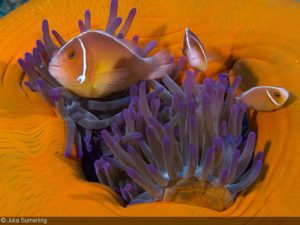
Pink anemonefish—a GBR classic!
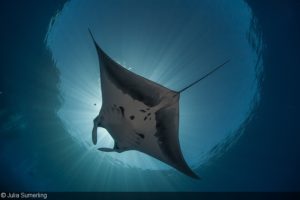
A manta ray soars overhead at the Holmes Reef
Tips and Techniques for the GBR and the Coral Sea
1. SS Yongala
- Use a wide-angle lens or a wide-angle attachment to capture the immense size of the wreck with the big schools of fish.
- If you can peel your eyes away from all the big stuff, there’s outstanding macro opportunities in the form of nudibranchs, snails, shrimps, and octopuses.
- There are often lots of particles in the water here and visibility is commonly only 30 to 50 feet. Maintaining good strobe placement is the most important thing to get right, as it will save you hours of editing later on. Strong currents can really move strobes around, so be sure to check and recheck them all the time.
- Diving with a nitrox blend of 32–34% will be advantageous. Having to leave the wreck because you are running out of deco time can be very frustrating, when the dive is so good and you still have another 15 minutes that you could spend there. Get certified before you go, if you are not already.
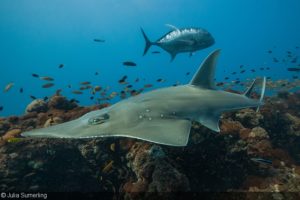
A shovelnose guitarfish glides over the wreck of the SS Yongala
2. Far Northern Great Barrier Reef
- Venturing into the shallows is always rewarding, as some of the most spectacular hard corals are found above 15 feet. This is where to shoot the classic over-under image for some really beautiful light on the corals. Knowing when the low and high tides are will help you choose the best time of day to try coral split shots.
- A 16–35mm lens is ideal to get that little bit closer to animals like sharks. For over-unders, use a wide-angle lens and the largest dome port you have. Use a short (60mm) or ideally long (100mm) macro lens for the small stuff.
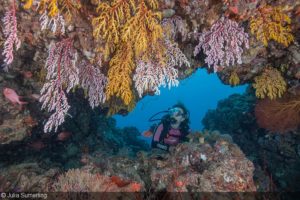
Spectacular colour at the far northern GBR
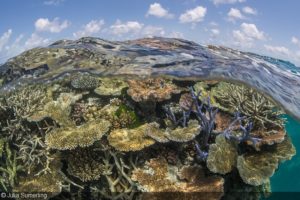
The shallow hard coral is a great opportunity to work on your split shots
3. North Horn, Osprey Reef, Coral Sea
- The Western Wall has everything. For Rhinopias, rare anthias, dart fish and scorpionfish, use a long (100mm) macro lens to fill the frame. Use the widest lens you have for all those stunning corals, and a 16–35mm lens to compose sharks in the frame perfectly.
- Sharks have really white bellies so when they are swimming close overhead, it’s very easy to overexpose them. To avoid ruining a great photo, make sure your strobes are set to half power or less.
- The red soft corals on the wall absorb a lot of light, so setting your strobes on high power is necessary to bring out the rich colours.
- Again, diving on nitrox will be very advantageous here.
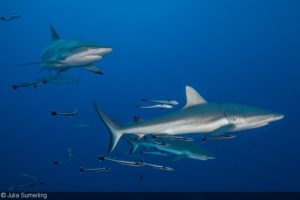
Gray reef sharks at North Horn
4. The Ribbon Reefs
- From larger subjects like turtles and potato cod to smaller critters like shrimps and nudibranchs, the Ribbon Reefs will give your lenses a serious workout. Unless you have a very flexible setup that allows you to quickly switch from macro to wide angle, it’s better to dedicate each dive to one or the other and plan accordingly.
- To find well-camouflaged macro subjects, work with a small group of divers. Alternatively, go with a dive guide, who will know where to look, as critters are often in the same places for months on end.
- Compact shooters should make use of the built-in macro settings, where applicable. Otherwise, use a dedicated macro wet lens attachment to focus really close.
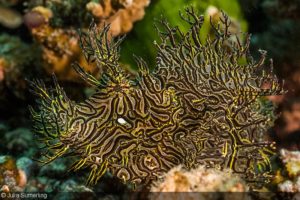
Rhinopias is a classic subject found on the Ribbon Reefs
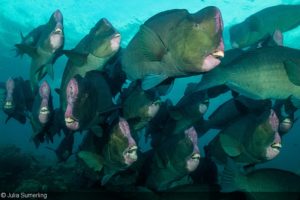
An early morning aggregation of bumphead parrotfish on the Ribbon Reefs
5. Minke Whale Season on the Ribbon Reefs
- At 72–75°F (22–24°C), the water temperature may sound quite warm, but many snorkelers are forced out of the water after an hour because they get too cold. Having a 7mm wetsuit will increase the amount of time you can stick around.
- If exciting, interactive encounters are happening, you don’t want to miss anything. Having spare batteries, memory cards and different lenses in a dry bag on the dive deck will shorten the time you’re away from the action.
- Make sure you regularly clean bubbles away from your port. They will often collect on the outside of the dome when at the surface.
- Use faster shutter speeds to avoid camera movement experienced at the surface. Compact shooters shouldn’t forget to remove red filters or white balance settings that you were using for diving.
- For most encounters, a standard wide-angle lens (16–35mm or 17–40mm) is ideal. A fisheye lens (10–17mm or 8–15mm) can be a little too wide, unless it’s one of the exceptional occasions during the year when the whales decide to come in really close.
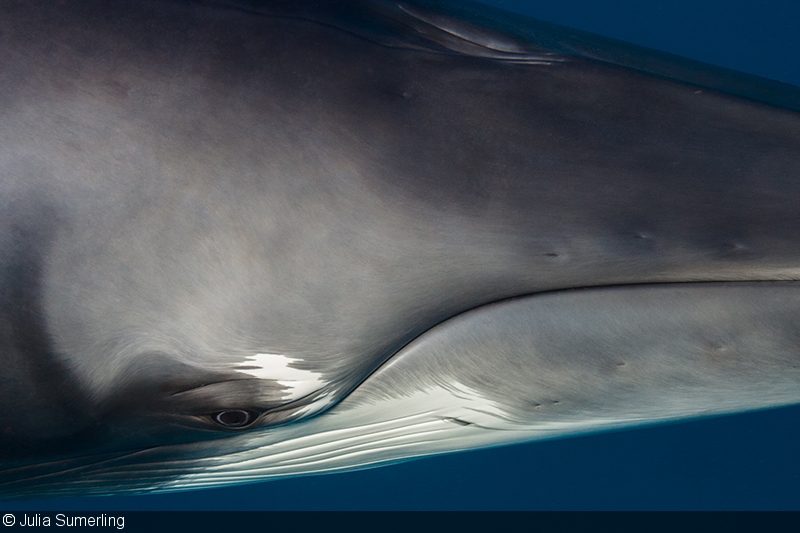
A graceful dwarf minke whale
6. Osprey, Bougainville and Holmes Reefs
- Leave the macro lens behind. This is the home of the classic images of rich blue waters and bright red fans, and if you’re lucky, you will get a shark swimming through it all.
- Try to get divers or wildlife in the background of fans and soft corals to give the viewer a sense of scale.
- While it’s all about the wide angle here, the determined macro photographer will come across different species of anemonefish to those found on the GBR. Look out for leafy scorpionfish watching over them or a porcelain crab hanging off the anemone.

Anthias hiding from hunting trevally at the Bougainville Reef
Planning Your Trip to the GBR and the Coral Sea
How to Get There: The gateway to the GBR, Cairns is accessible via direct international flights from places such as Singapore, Manila, Tokyo, and Bali. Qantas, Virgin Australia and Jetstar offer direct services to Cairns from nearly all of Australia’s state capitals.
When to Go: The GBR’s Ribbon Reefs and the Coral Sea’s Osprey, Bougainville, and Holmes Reefs are year-round destinations, though the water clarity in the Coral Sea can be particularly good from October to January, which is also the best time to visit the far northern GBR, when the prevailing southeasterly winds drop. The SS Yongala is best visited from May to January, after the wet season, while the minke whale season on the Ribbon Reefs happens every winter, in June and July.
Hotels: Cairns offers a wide selection of accommodations to suit all budgets and tastes if you require a place to stay before or after your trip. Check with Mike Ball Dive Expeditions for preferential rates.
Visas: All foreign visitors to Australia require a visa, applied for online. Passport holders from Europe are generally eligible for a free eVisitor visa. An Electronic Travel Authority (ETA) is also available for most European nationals as well as passport holders from Brunei, Hong Kong, Japan, Malaysia, Singapore, South Korea, Canada, and the USA.
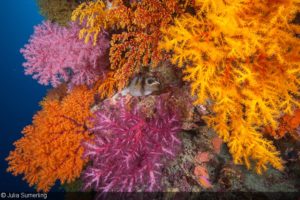
The Western Wall at North Horn, Osprey Reef: The amazingly vibrant colours found in the Coral Sea will stay with you long after you return home
The post An Underwater Photographer’s Guide to the Great Barrier Reef appeared first on Mike Ball Dive Expeditions.
Read More Go to Mike Ball Archive Mike Ball Dive Expeditions
